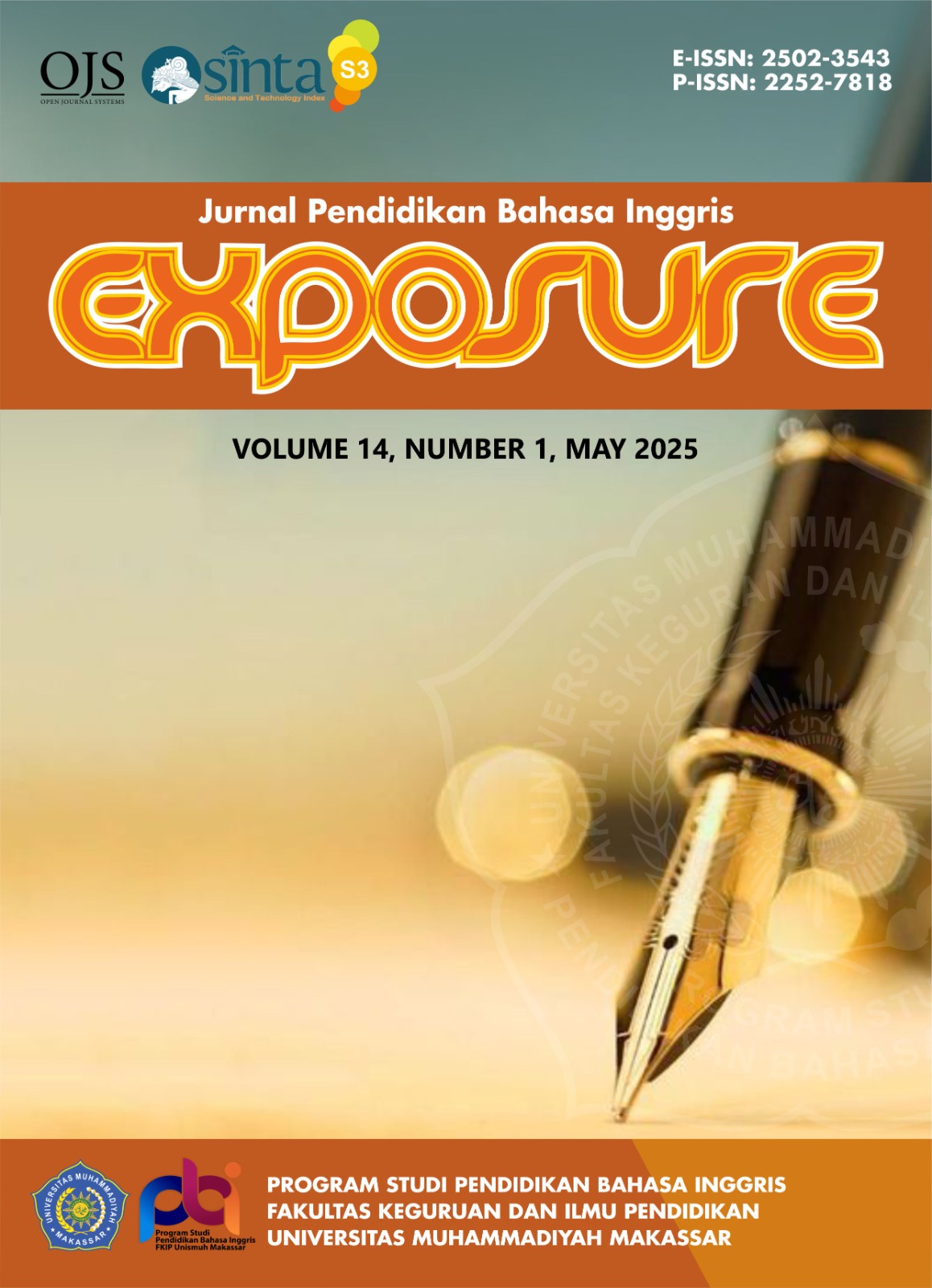THE APPLICATION OF CHORAL AND REPEATED READING STRATEGY TO IMPROVE READING COMPREHENSION OF THE EIGHTH GRADE STUDENTS AT SMP NEGERI 20 SIGI
DOI:
https://doi.org/10.26618/exposure.v14i1.15301Keywords:
Choral and repeated reading, Reading comprehension, Text narative, Short storyAbstract
This study aimed to evaluate the effectiveness of choral and repeated reading strategies in improving the reading comprehension of eighth-grade students at SMP Negeri 20 Sigi. Using a quasi-experimental design, 46 students were selected through cluster random sampling and divided into experimental and control groups. Data were collected through multiple-choice and essay tests administered before and after the intervention. The experimental group’s mean pretest score was 45.96, increasing to 81.35 post-test, while the control group’s mean rose from 50.30 to 76.04. Statistical analysis showed significant improvement, supported by a two-tailed significance value of 0.000 and a correlation coefficient of 0.696. These findings confirm that choral and repeated reading strategies positively impact students' reading comprehension.
References
Bean, L., 2017. Choral Reading. Accessed on 2017/02/23 (https://education.byu.edu/sites/default/files/ARTS/documents/LisaBe an Choral Readig.p df)
Birsh, J. R., & Carreker, S. (2018), Multisensory teaching of basic language skills (4th ed.). Paul H. Brookes Publishing.
Hasibuan, A., Irmayana, A., & Siregar, O. 2021. An Analysis of Students’ difficulties on Reading Comprehension of Descriptive Text at The Eighth Grade of SMP Negeri 2 Barumun Tengah in 2020/2021 academic year. Journal education and development, 9 (3), 605-608.
Irwanto & Nurpahmi, S. 2017. Menggunakan Make-A Match untuk Meningkatkan Pemahaman Membaca Siswa Di MTS Guppi Samata Gowa. Jurnal UIN Alauddin Makassar. Jilid 3 Nomor 02 Tahun 2017: 161-172.
Kirby, J. R. (2014). Reading comprehension: its nature and development. Encyclopedia of Language and Literacy Development, 1-8. https://citeseerx.ist.psu.edu/viewdoc/download?doi=10.1.1.605.9849&rep=re p1&type=pdf
Lee, J., & Yoon, S. Y. (2017). The effects of repeated reading on the fluency and comprehension skills of elementary-age students with learning disabilities. Journal of Learning Disabilities, 50(2), 213-224.
Mardianti, V., Jos. E.,& Ohoiwutun, W. (2014). Improving students’ reading comprehension through schema activation strategy. E-Journal of English Language Teaching Society ELTS),2 (1), 1-16. Retrieved from http://jurnal.untad.ac.id/index.ph p/ELTS/article/view/3020.
Nurhamdani, S., Korompot, C. A., Sakkir, G., Makassar, U. N., Makassar, U. N., Makassar, U. N., Information, A., & Strategy, R. R. (2023). the Implementation of Choral and Repeated Reading Strategy (Crrs) To Improve the Reading Ability of Year 7 Students At Upt Smpn 1 Сетра. 1(1), 19-23.
Sari, D. P. (2018). The implementation of flipped classrooms assisted by a learning management system for numerical method courses. 274, 158-162. https://doi.org/10.2991/iccite-18.2018.36
Septiawan, T. R. (2021). The influence of using choral reading (CR) strategy towards students reading comprehension in narrative text of the eighth grade of SMP Negeri 1 Terbanggi Besar academic year of 2020/2021. Retrieved March, 16th 2022, from http://repository.radenintan.ac.id/id/eprint/15957.
Yang, X. (2016). Study on factors affecting learning strategies in reading comprehension. Journal of Language Teaching and Research. 7(3). 586 590. DOI: http://dx.doi.org/10.1750/jltr.070 3.21
Zorella, Nadia (2017). Increasing the Students' Reading Comprehension Through Choral Reading Strategy at Seventh Grade of Private Islamic Junior High School Jami' Al kautsar Tapung Hilir. Universitas Islam Negeri Sumatera Utara
Downloads
Published
Issue
Section
License
Authors who publish with this journal agree to the following terms:
In order to assure the highest standards for published articles, a peer review policy is applied. In pursue of the compliance with academic standards, all parties involved in the publishing process (the authors, the editors and the editorial board and the reviewers) agree to meet the responsibilities stated below in accordance to the Journal publication ethics and malpractice statement.
Duties of Authors:
- The author(s) warrant that the submitted article is an original work, which has not been previously published, and that they have obtained an agreement from any co-author(s) prior to the manuscript’s submission;
- The author(s) should not submit articles describing essentially the same research to more than one journal;
- The authors(s) make certain that the manuscript meets the terms of the Manuscript Submission Guideline regarding appropriate academic citation and that no copyright infringement occurs;
- The authors(s) should inform the editors about any conflict of interests and report any errors they subsequently, discover in their manuscript.
Duties of Editors and the Editorial Board:
- The editors, together with the editorial board, are responsible for deciding upon the publication or rejection of the submitted manuscripts based only on their originality, significance, and relevance to the domains of the journal;
- The editors evaluate the manuscripts compliance with academic criteria, the domains of the journal and the guidelines;
- The editors must at all times respect the confidentiality of any information pertaining to the submitted manuscripts;
- The editors assign the review of each manuscript to two reviewers chosen according to their domains of expertise. The editors must take into account any conflict of interest reported by the authors and the reviewers.
- The editors must ensure that the comments and recommendations of the reviewers are sent to the author(s) in due time and that the manuscripts are returned to the editors, who take the final decision to publish them or not.
Authors are permitted and encouraged to post online a pre-publication manuscript (but not the Publisher’s final formatted PDF version of the Work) in institutional repositories or on their Websites prior to and during the submission process, as it can lead to productive exchanges, as well as earlier and greater citation of published work (see The Effect of Open Access). Any such posting made before acceptance and publication of the Work shall be updated upon publication to include a reference to the Publisher-assigned DOI (Digital Object Identifier) and a link to the online abstract for the final published Work in the Journal.




